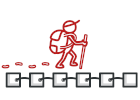
Ruby 迭代器模式讲解和代码示例
迭代器是一种行为设计模式, 让你能在不暴露复杂数据结构内部细节的情况下遍历其中所有的元素。
在迭代器的帮助下, 客户端可以用一个迭代器接口以相似的方式遍历不同集合中的元素。
复杂度:
流行度:
使用示例: 该模式在 Ruby 代码中很常见。 许多框架和程序库都使用它来提供遍历其集合的标准方式。
识别方法: 迭代器可以通过导航方法 (例如 next和 previous等) 来轻松识别。 使用迭代器的客户端代码可能没有其所遍历的集合的直接访问权限。
概念示例
本例说明了迭代器设计模式的结构并重点回答了下面的问题:
- 它由哪些类组成?
- 这些类扮演了哪些角色?
- 模式中的各个元素会以何种方式相互关联?
main.rb: 概念示例
class AlphabeticalOrderIterator
# In Ruby, the Enumerable mixin provides classes with several traversal and
# searching methods, and with the ability to sort. The class must provide a
# method each, which yields successive members of the collection.
include Enumerable
# This attribute indicates the traversal direction.
attr_accessor :reverse
private :reverse
# @return [Array]
attr_accessor :collection
private :collection
# @param [Array] collection
# @param [Boolean] reverse
def initialize(collection, reverse: false)
@collection = collection
@reverse = reverse
end
def each(&block)
return @collection.reverse.each(&block) if reverse
@collection.each(&block)
end
end
class WordsCollection
# @return [Array]
attr_accessor :collection
private :collection
def initialize(collection = [])
@collection = collection
end
# The `iterator` method returns the iterator object itself, by default we
# return the iterator in ascending order.
def iterator
AlphabeticalOrderIterator.new(@collection)
end
# @return [AlphabeticalOrderIterator]
def reverse_iterator
AlphabeticalOrderIterator.new(@collection, reverse: true)
end
# @param [String] item
def add_item(item)
@collection << item
end
end
# The client code may or may not know about the Concrete Iterator or Collection
# classes, depending on the level of indirection you want to keep in your
# program.
collection = WordsCollection.new
collection.add_item('First')
collection.add_item('Second')
collection.add_item('Third')
puts 'Straight traversal:'
collection.iterator.each { |item| puts item }
puts "\n"
puts 'Reverse traversal:'
collection.reverse_iterator.each { |item| puts item }
output.txt: 执行结果
Straight traversal:
First
Second
Third
Reverse traversal:
Third
Second
First
 冬季促销!
冬季促销!
